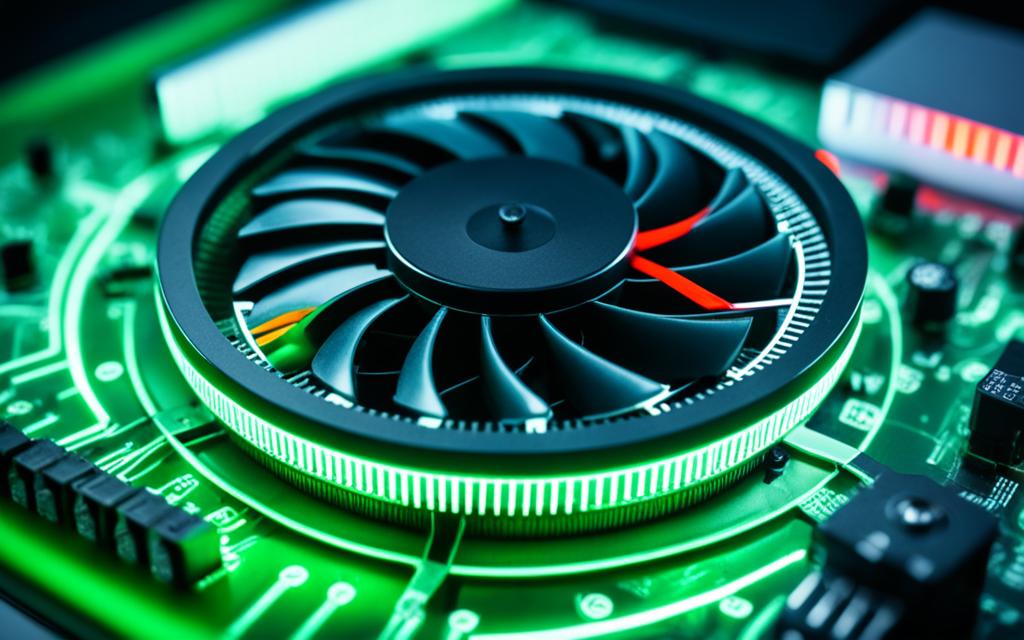Table of Contents
The performance and longevity of your CPU are closely linked to its temperature. A normal CPU temperature when idle is between 30°C and 40°C (86°F to 104°F)1. Under normal use, CPUs work well between 60°C and 70°C (140°F to 158°F)2.
It is important to keep an eye on these temperatures. Overheating above 80°C (176°F) can damage your CPU and lower its performance1. By using the right cooling methods, you can reduce overheating risks. This ensures your computer works at its best. Keeping an eye on CPU temperatures is crucial for its efficiency and to prevent it from failing.
Key Takeaways
- Safe CPU temperature ranges generally lie between 30°C and 40°C when idle.
- During heavy loads, CPU temperatures can rise to between 70°C and 80°C.
- Keeping CPU temperatures below 80°C is crucial for preventing damage.
- Regular monitoring is key to ensuring optimal CPU performance.
- Environmental factors and cooling efficiency play a significant role in CPU temperatures.
- Overclocking can increase CPU temperatures, highlighting the necessity for diligent monitoring.
Understanding CPU Temperatures
Understanding what causes CPU temperatures to rise is crucial for keeping your computer stable. CPU heat causes mainly come from the processor’s electrical activities. This happens a lot during intense tasks like gaming or video editing. High power usage leads to higher temperatures, which makes thermal management very important.
What Causes CPU Heat?
There are a few main reasons for CPU heating up:
- Heavy workloads during demanding tasks.
- Dust buildup inside the computer, which blocks airflow.
- Poor cooling systems.
- Changes in the room temperature that make the CPU run hotter.
Studies show room temperature changes can make CPU temperatures go up by 5 to 10°C. For each degree the room heats up, the CPU temperature can go up by 1 to 1.5°C3. That’s why it’s a good idea to keep an eye on your CPU’s temperature often.
The Importance of Monitoring CPU Temperatures
Checking CPU temperatures regularly is very important. This helps avoid too much heat, which can slow down or damage your computer. For gamers, it’s best to keep the CPU under 85°C. Exactly how hot your CPU should get depends on what you’re doing:
| Load Condition | Ideal Temperature | Good Temperature | Risky Temperature | Danger Temperature |
|---|---|---|---|---|
| Idle | < 50°C | 50 – 65°C | 65 – 75°C | > 75°C |
| Low Load | < 70°C | 70 – 80°C | 80 – 85°C | > 85°C |
| Max Load | < 80°C | 80 – 85°C | 85 – 90°C | > 90°C |
Letting your CPU get too hot can hurt its performance and even damage it. Using CPU temperature monitoring software and good upkeep can protect your system.
What Is a Safe Temp for CPU
Knowing the safe temperature for a CPU is important for keeping it working well. Safe temperature ranges differ by processor type and maker’s guidelines. Most CPUs can run from 50°C to 80°C safely under typical use. For high-performance CPUs, temperatures up to 90°C might still be safe4.
Normal Temperature Ranges Under Various Loads
Under normal use, CPUs usually stay between 40-60 degrees Celsius. When running big programs, they can get up to 80 degrees Celsius5. While these temperatures are okay, going over 90 degrees Celsius could be worrisome6. Continuously operating above 85°C could affect the CPU’s stability and life6.
Recognising Red Flags in CPU Temperatures
Being aware of CPU temperature warnings is key. A CPU that often goes beyond 90 degrees Celsius might be too hot. This can cause performance drops or serious damage5. For instance, old i5 or i7 CPUs at 97 degrees Celsius for little to no reason show cooling issues5. Additionally, CPUs might lower their speed to cool down if they get too hot, impacting performance6.
| Condition | Temperature (°C) | Status |
|---|---|---|
| Normal Use | 40-60 | Safe |
| Heavy Load | 70-80 | Acceptable |
| High-Performance Workload | 90 | Concerning |
| Excessive Heat | Over 100 | Critical |
Using tools like HWMonitor or Core Temp is a good idea. They help make sure your CPU’s temperature stays safe. This way, you avoid problems caused by too much heat4.
How to Check Your CPU Temperature
Knowing how to check your CPU temperature well is key to keeping your system healthy and running smoothly. There are different ways to do this, each with its own pros and cons.
Using Built-in BIOS/UEFI Utilities
One way to check your CPU’s temperature is through the BIOS or UEFI settings. Pressing F2 or DEL when your computer starts up lets you see this info. This approach gives you the temperature right away. But, it won’t show you past temperatures. So, it’s good for a quick look but not for watching changes over time.
Third-party Software for Monitoring
If you want more detail, you can use CPU monitoring software. Tools like Core Temp, HWMonitor, and NZXT CAM show deep temperature details and keep records. These are great for gamers or anyone putting heavy loads on their computers. They let you spot safe temperatures like 70°C to 85°C when busy, and warn you about dangerous levels over 90°C7.
They also watch out for overheating from things running in the background or malware7.
Infrared Thermometer Method
Another way to check the temperature is with an infrared thermometer. This tool measures the CPU temperature without touching your computer. It lets you monitor the temperature live without messing with the computer’s workings. It’s handy for those who want exact numbers without opening up their PCs.
| Method | Description | Pros | Cons |
|---|---|---|---|
| BIOS/UEFI | Access during boot-up | Fast access, no software required | No historical data |
| Third-party Software | Continuous monitoring | Detailed analytics, alerts | Requires installation |
| Infrared Thermometer | Non-invasive temperature check | Real-time measurement | May be less accurate on some surfaces |
Keeping your CPU at the right temperature is very important. Going over 95 degrees Celsius is usually a bad sign for most CPUs8. By using the methods we talked about, you can keep an eye on your CPU’s temperature. This ensures it performs at its best.
Factors Influencing CPU Temperatures
Understanding factors influencing CPU heat is key for top performance. It’s vital to consider the surroundings of your computer. High room temperatures or poor airflow can block effective cooling. This leads to overheating risks.
If a computer is in a cramped space, keeping it cool becomes harder, especially in hot places. This shows how the environment affects CPU temperature control9.
The cooling efficiency of your setup is also crucial. Use top coolers and good thermal paste to remove heat better. Making sure heat sinks touch the CPU well and cleaning dust are important. For instance, the Cooler Master Hyper TX3 cooler makes cooling much more efficient10.
Overclocking improves CPU speed but has its risks. It can make the CPU hotter, needing better cooling. Keeping an eye on temperature helps avoid harm and keeps the system running longer9. For tips on keeping your CPU cool, check out this guide on CPU cooling here.
FAQ
What is the ideal temperature range for my CPU?
The safe CPU temperature is usually between 30°C and 40°C at rest. When working hard, it should be between 60°C and 80°C. Staying within these limits helps your CPU run well and last longer.
Why is it important to monitor CPU temperatures?
Checking your CPU’s temperature often is key. High temperatures can cause overheating. This can harm your computer, slow it down, and make it unstable. By keeping an eye on temperatures, you keep your system steady and working.
How can I tell if my CPU is overheating?
If your CPU often gets hotter than 80°C under a heavy load, it’s too hot. When it stays this warm, your computer might slow down. This is because it tries to cool down, affecting its speed.
What tools can I use to check my CPU[1] temperature?
You can find out your CPU’s temperature in several ways. Use your computer’s BIOS/UEFI, or try software like Core Temp, NZXT’s Cam, or HWInfo. An infrared thermometer can also measure it without touching anything.
How do environmental conditions affect CPU temperature?
The temperature and airflow around your computer can change how well it cools down. Keeping your computer in a cool, airy space helps it stay at the right temperature.
What cooling solutions are effective for CPUs?
Good cooling for your CPU includes quality fans and heatsinks. You should also use thermal paste correctly. Cleaning dust off parts regularly keeps air moving and heat away.
Does overclocking my CPU affect its temperature?
Overclocking makes your CPU work harder, which makes it hotter. It’s very important to watch the temperature when you do this. This keeps it from getting too hot and being damaged.
Source Links
- https://www.noyafa.com/blogs/knowledge-base/good-cpu-temperature – What Is A Good CPU Temperature? A Guide to Keep Your Processor Cool
- https://www.avast.com/c-how-to-check-cpu-temperature – How to Check and Monitor Your CPU Temperature
- https://www.buildcomputers.net/cpu-temperature.html – CPU Temperature – What are the Normal and Maximum CPU Temps?
- https://www.lenovo.com/us/en/glossary/what-is-cpu-temperature/ – Cpu Temperature: What is CPU Temperature?
- https://community.spiceworks.com/t/what-is-a-normal-temperature-for-a-cpu-and-how-do-i-keep-it-low/948818 – What is a normal temperature for a CPU and how do I keep it low?
- https://forums.tomshardware.com/threads/is-my-cpu-temperature-safe.3725283/ – [SOLVED] – Is my cpu temperature safe?
- https://www.pandasecurity.com/en/mediacenter/how-to-check-cpu-temp/ – How to Check Your CPU Temperature – Panda Security
- https://www.tomshardware.com/how-to/how-to-check-cpu-temp-temperature – How to Check Your CPU Temperature
- https://outbyte.com/blog/good-safe-cpu-temperature-check-optimize/ – Good and Safe CPU Temperature — How to Check and Optimize?
- https://www.pugetsystems.com/labs/articles/impact-of-temperature-on-intel-cpu-performance-606/ – Impact of Temperature on Intel CPU Performance








